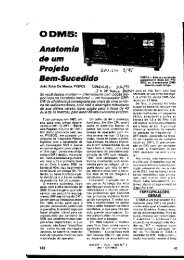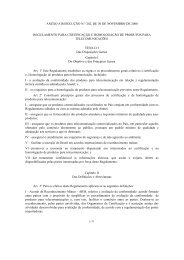A Software Defined Radio for the Masses, Part 3
A Software Defined Radio for the Masses, Part 3
A Software Defined Radio for the Masses, Part 3
You also want an ePaper? Increase the reach of your titles
YUMPU automatically turns print PDFs into web optimized ePapers that Google loves.
domain. I would appreciate comments<br />
from knowledgeable readers on this<br />
hypo<strong>the</strong>sis.<br />
The IFFT and Overlap/Add—<br />
Conversion Back to <strong>the</strong> Time<br />
Domain<br />
Be<strong>for</strong>e returning to <strong>the</strong> time domain,<br />
we must first convert back to<br />
Cartesian coordinates by using<br />
nspdbrPolarToCart as illustrated in<br />
Fig 15. Then by setting <strong>the</strong> NSP_Inv<br />
flag, <strong>the</strong> inverse FFT is per<strong>for</strong>med by<br />
nspzrFftNip, which places <strong>the</strong> timedomain<br />
outputs in RealOut() and<br />
ImagOut(), respectively. As discussed<br />
previously, we must now overlap and<br />
add a portion of <strong>the</strong> signal from <strong>the</strong><br />
Fig 17—Digital AGC flow diagram.<br />
8 Nov/Dec 2002<br />
previous capture cycle as described in<br />
<strong>the</strong> DSP Guide (see Note 13).<br />
Ioverlap() and Qoverlap() store <strong>the</strong> inphase<br />
and quadrature overlap signals<br />
from <strong>the</strong> last pass to be added to <strong>the</strong><br />
new signal block using <strong>the</strong> nspdbAdd3<br />
routine.<br />
Digital AGC with<br />
Variable Hang Time<br />
The digital AGC code in Fig 16 provides<br />
fast-attack and -decay gain control<br />
with variable hang time. Both attack<br />
and decay occur in approximately<br />
1 ms, but <strong>the</strong> hang time may be set to<br />
any desired value in increments of<br />
46 ms. I have chosen to implement <strong>the</strong><br />
attack/decay with a linear ramp<br />
function ra<strong>the</strong>r than an exponential<br />
function as described in DSP communications<br />
texts. 15 It works extremely<br />
well and is intuitive to code. The flow<br />
diagram in Fig 17 outlines <strong>the</strong> logic<br />
used in <strong>the</strong> AGC algorithm.<br />
Refer to Figs 16 and 17 <strong>for</strong> <strong>the</strong> following<br />
description. First, we check to<br />
see if <strong>the</strong> AGC is turned on. If so, we<br />
increment AGCLoop, <strong>the</strong> counter <strong>for</strong><br />
AGC hang-time loops. Each pass<br />
through <strong>the</strong> code is equal to a hang time<br />
of 46 ms. PC SDR provides hang-time<br />
loop settings of 3 (fast, 132 ms), 5 (medium,<br />
230 ms), 7 (slow, 322 ms) and 22<br />
(long, 1.01 s). The hang-time setting is<br />
stored in <strong>the</strong> AGCHangvariable. Once<br />
<strong>the</strong> hang-time counte resets, <strong>the</strong> decay











